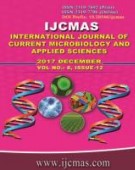


 National Academy of Agricultural Sciences (NAAS)
National Academy of Agricultural Sciences (NAAS)

|
PRINT ISSN : 2319-7692
Online ISSN : 2319-7706 Issues : 12 per year Publisher : Excellent Publishers Email : editorijcmas@gmail.com / submit@ijcmas.com Editor-in-chief: Dr.M.Prakash Index Copernicus ICV 2018: 95.39 NAAS RATING 2020: 5.38 |
Recently, Acinetobacter has emerged as significant hospital pathogen, notoriously known to acquire antibiotic resistance to most of the commonly prescribed antimicrobials. Many risk factors are associated with Acinetobacter infections, especially in patients in intensive care unit (ICU). This study aims to isolate Acinetobacter from various clinical specimens and to determine its antimicrobial sensitivity pattern. Identification, speciation and antimicrobial sensitivity testing were performed using the standard microbiological techniques. From the processed clinical specimens, 88 Acinetobacter strains were isolated. Significantly higher percentage of Acinetobacter strains was found in ICU compared with general wards Most common Acinetobacter samples were from blood Infections were more common in males and were associated with major risk factors such as post-surgical, diabetes mellitus, catheterization, extended hospital stay and prolonged antibiotic usage. Acinetobacter baumanii was the most common species isolated from blood, (septisemeas) pus (wound infection), etc. Imipenem was most sensitive drug 73 (82.95%) followed by colistin 62(70.45%), Tygycyclin 59(67.05%), cproflaxacin 55(62.50%), cefoperazone + sulbactum 55(62.50%) oflaxacin 54(61.36%), amikacin 53(60.23%), gentamycin 52 (59.09%). Highest resistance is seen in ampicillin.70 (79.35%) followed by cefixime 66(75.00%), cefriaxone 62(70.45%), amoxicillin + clavulanic acid (61(69.23%), cephotoxime 57(64,77%), ticarcillin+clavulanic acid 54(61,35%) co-trimoxazole 49(55.68%), piperacillin + tazobactim 40(45,45%). Acinetobacter nosocomial infections resistant to most antimicrobials have emerged, especially in ICU. Early identification and continued surveillance of prevalent organism will help prevent the spread of Acinetobacter in hospital environment
 |
 |
 |
 |
 |